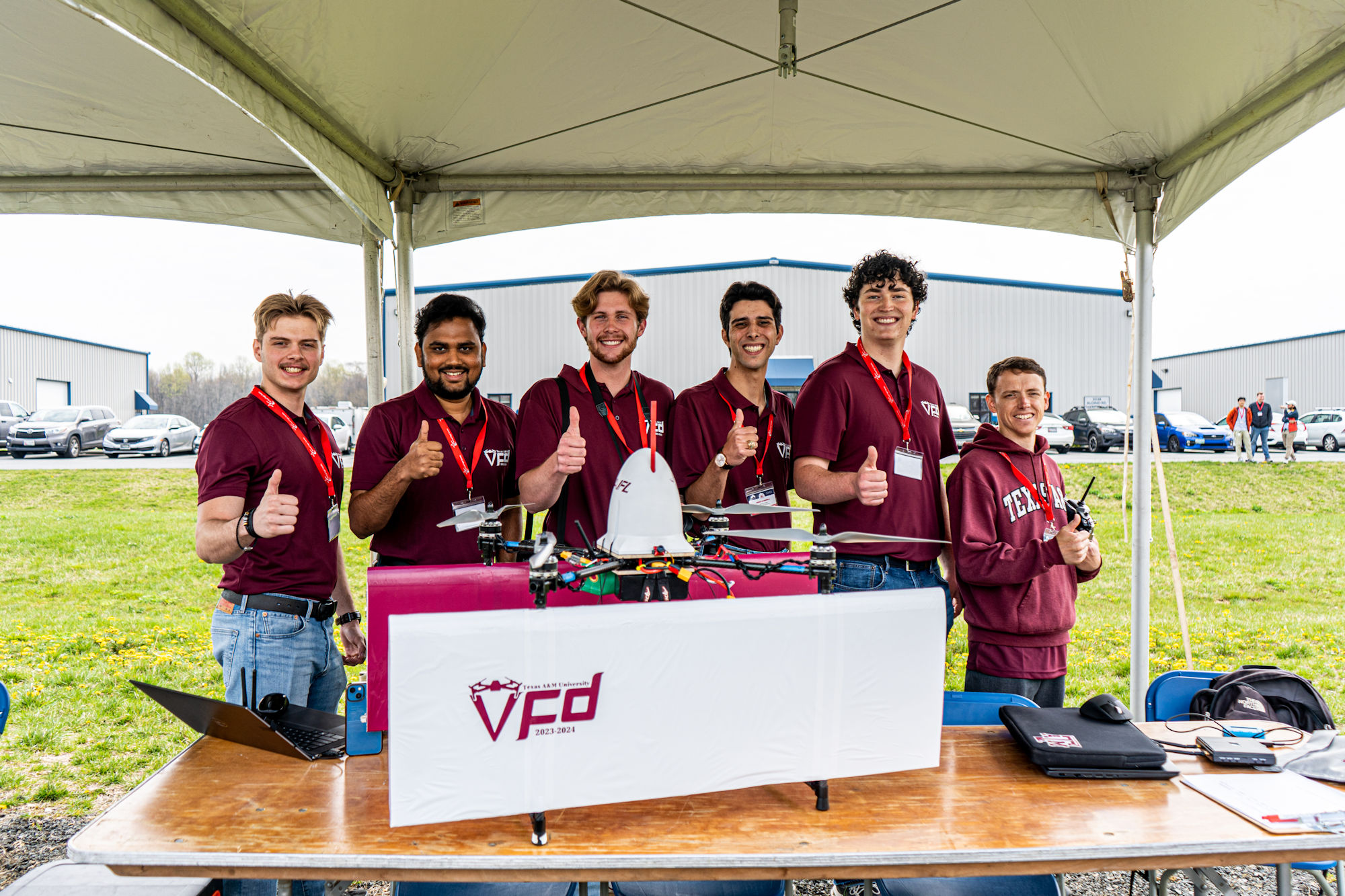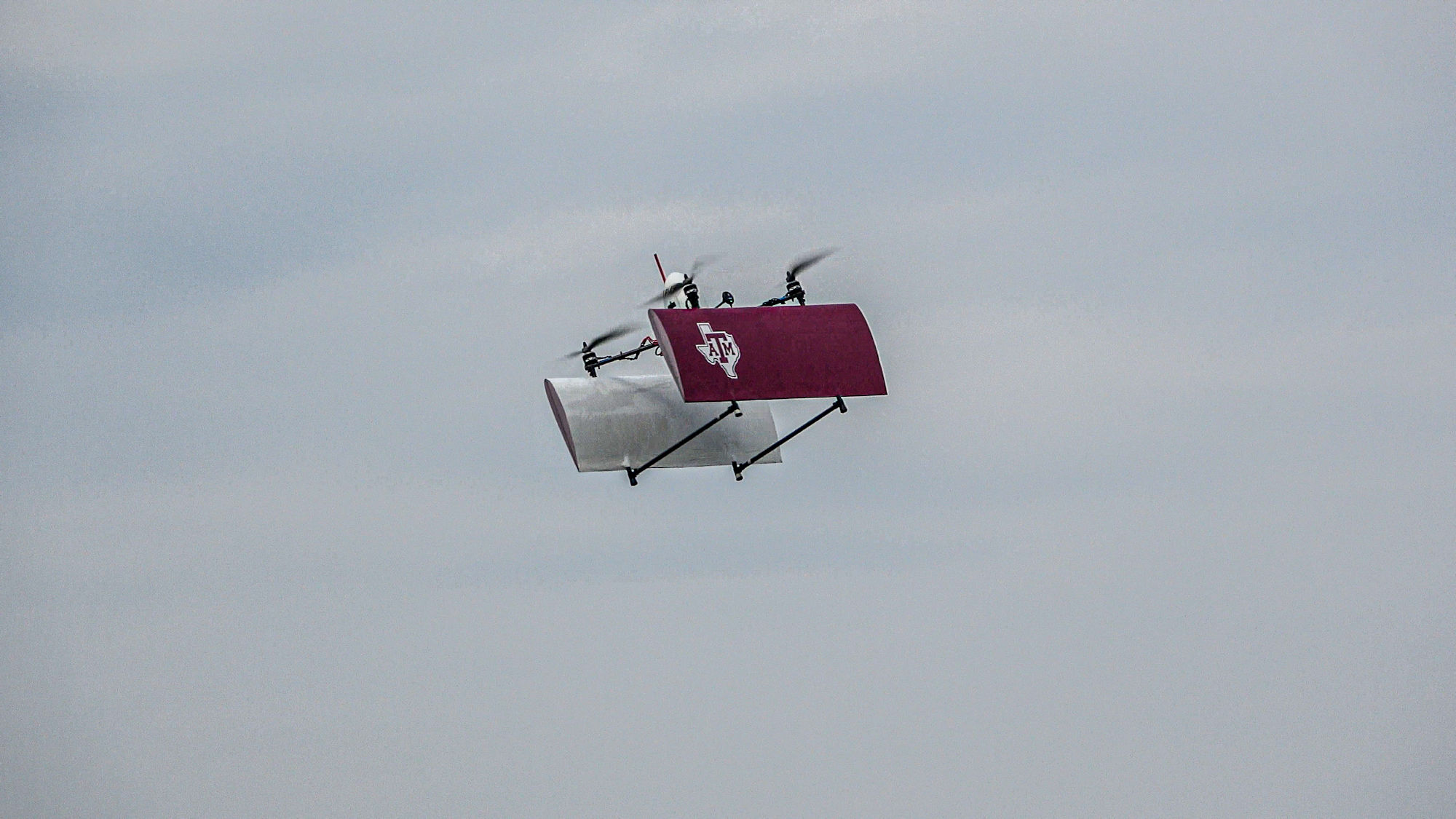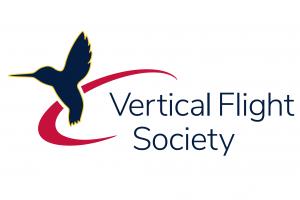
Vertical Flight Society Announces the Winners of the 4th Annual Design-Build-Vertical Flight Competition
Texas A&M took first place, University of Maryland took second and the Georgia Tech took third. VFS awarded a total of more than $5,000 in the competition.
This year’s DBVF student competition was a great success. Of the original 16 teams that entered the competition in October, nine teams flew a wide range of exotic aircraft designs at the culminating event in Churchville, Maryland, on April 10–12, 2024. The competition required the university teams to complete several deliverables throughout the year, including a final technical report, an on-site team presentation, a manually piloted flight performance course and a fully autonomous flight course. The original 16 teams included a spread of universities across the United States, along with entrants from Malaysia, India and Canada.
This annual electric-powered vertical take-off and landing (VTOL) uncrewed aircraft system (UAS) competition seeks to encourage interest in vertical flight, electric aviation, autonomy and uncrewed systems technology, as well as small air vehicle design and fabrication. The competition is designed to develop hands-on skills and familiarization with eVTOL technology at the university student level and prepare the next generation of engineers and leaders to push the limits of this exciting technology into the future. More information on the competing teams and competition requirements can be found at www.vtol.org/fly.
SURVICE Engineering hosted the competition flyoff for the second year in a row at its Applied Technology Operation (ATO) at Harford County Airport in Churchville, Maryland. Teams flew their custom designed and hand-built drones in SURVICE’s flight operations area, which it operates under a Federal Aviation Administration (FAA) Certificate of Waiver or Authorization (COA). The drones were limited to a maximum takeoff weight of 20 lb (9 kg) and a maximum dimension of 10 ft (3 m).
All nine of the teams attending the in-person competition recorded flight time, five of the teams meeting a significant amount of the flyoff competition deliverables. Teams were required to manually pilot their aircraft over a rectangular course, with a vertical takeoff and landing on each lap to simulate the real operation of these drones and test their vehicle’s efficiency in both hovering performance and cruise endurance. The autonomous attempt required the vehicle to take off, navigate the course, and land, all while the pilot’s hands were off the control sticks. Four teams completed the autonomous course requirement.
The week in Churchville delivered some harsh weather conditions for the teams to fly in. Winds at 20 mph (32 km/h) gusting 40 mph (64 km/h) set the stage for a number of extreme crashes throughout the competition. Several of the teams bounced back after significant crashes, however, repairing their drones and getting back out on the flight line. A majority of the teams pursued challenging VTOL configurations such as tailsitter aircraft, biplane tailsitters, and even a tiltrotor like the V-22 Osprey. Strong winds on Thursday afternoon and a minor flight test incident resulted in the flight line being closed down on Thursday afternoon. The event continued, however, with some of the team presentations and a fantastic tour of the SURVICE operations. Presenting teams had to work around the buzz of the adjacent and highly active runway. Various piston and turboprop aircraft were taking flight throughout the week, and even a Sikorsky UH-60 Black Hawk and a Bell 206 JetRanger made appearances.
Torrential rain Thursday evening spilled over into Friday morning. The North Carolina Agricultural and Technical State University (NC A&T), who had a tenuous fully autonomous landing the day prior, attempted to fly in the gale-like storm Friday morning. While the other teams hunkered down in the large carnival tent with several thousand pounds of concrete blocks securing it firmly to the runway, the NC State Hover Hounds covered their drone in a garbage bag to protect the electronics from the elements for a successful flight. Several other teams squeezed in successful last-minute flights despite the unfavorable flying conditions.
For the overall competition scoring, which included the combined scores from the technical report, team presentations, and flyoff performance, the Texas A&M University took home the 1st place prize and $2,750 with their impressive biplane tailsitter aircraft, the University of Maryland secured 2nd and $1,125, and the Georgia Institute of Technology earned 3rd place and received $650; Embry-Riddle Aeronautical University received $500 for the Best Technical Report. SURVICE Engineering staff presented the “Best Crash” award to the University of Maryland for a nose-dive from a 100-ft (30-ft) altitude, and “Best New Entrant” to NC A&T for their ingenuity and resilience in combatting the weather.
In addition to SURVICE Engineering, which hosted the event and helped run the competition, Supernal was the Gold Sponsor and Ansys made its simulation software available to the teams.
“We would like to thank the many volunteers that help throughout the year to pull off the event, as well as the several reviewers, judges, and SURVICE staff that provide teams feedback on their deliverables and the opportunity to fly their aircraft competitively at the culminating event,” said Dr. Jason K. Cornelius of NASA Ames Research Center, who volunteers as the VFS DBVF Program Director. “Overall, the 4th Annual VFS DBVF competition was a monumental success, with teams working together to help each other overcome setbacks and push their aircraft to the limits. VFS looks forward to the 5th Annual DBVF competition, and for new university teams and supporters from around the world to join in on the fun.”
Founded as the American Helicopter Society in 1943, the Vertical Flight Society is the global non-profit society for engineers, scientists and others working on vertical flight technology. For more than 80 years, the Society has led technical, safety, advocacy and other important initiatives, and has been the primary forum for interchange of information on vertical flight technology.
Mike Hirschberg
Vertical Flight Society
+1 703-684-6777
pr@vtol.org
Visit us on social media:
LinkedIn
Facebook
Twitter
Instagram
YouTube
Other
EIN Presswire does not exercise editorial control over third-party content provided, uploaded, published, or distributed by users of EIN Presswire. We are a distributor, not a publisher, of 3rd party content. Such content may contain the views, opinions, statements, offers, and other material of the respective users, suppliers, participants, or authors.




